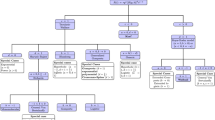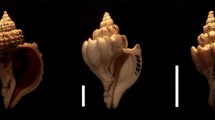Abstract
The assumption that a single growth equation can be used to describe all biological objects on different organizational levels and a dimensional analysis are applied in order to substantiate universal model of ontogenetic growth. This model (the mass of a growing organism is a power function of time) is valid only in the initial period of growth. For the whole period of growth, a generalization of the model is advanced; it provides the same accuracy as previously known models of quantitative description of kinetic curves. Within the scope of the developed model, a number of interesting results related to allometry and biological time are obtained.


Similar content being viewed by others
References
Andresen B, Shiner JS, Uehlinger DE (2002) Allometric scaling and maximum efficiency in physiological Eigen time. PNAS 99(9):5822–5824
Aoki I (1989) Entropy flow and entropy production in the human body in basal conditions. J Theor Biol 141:11–21
Aoki I (1991) Entropy principle for human development, growth and aging. J Theor Biol 150:215–223
Backman G (1943) Wachstum und organische zeit. Leipzig, Barth
Boddington MJ (1978) An absolute metabolic scope for activity. J Theor Biol 75:443–449
Bridgman PW (1922) Dimensional analysis. Yale Univ Press, New Haven
Brody S (1945) Bioenergetics and growth. Hafner Publishing, New York
Capellini I, Venditti C, Barton RA (2010) Phylogeny and metabolic scaling in mammals. Ecology 91(9):2783–2793
Carrel A (1929) Physiological time. Science 74:618–621
Dettlaff TA (1986) The rate of development in poikilothermic animals calculated in astronomical and relative time units. J Therm Biol 11
Dmi’el R (1967) Studies on reproduction, growth, and feeding in the snake Spalerosophis cliffordi (Colubridae). Copeia 1967(2):332–346
Forsyth DJ (1976) A field study of growth and development of nestling masked shrews (Sorex cinereus). J Mammal 57(4):708–721
France J, Dijkstra J, Dhanoa MS (1996) Growth functions and their application in animal science. Ann Zootech 45:165–174
Gayon J (2000) History of the concept of allometry. Am Zool 40(5):748–758
Gier HT (1947) Growth rate in the cockroach Periplaneta americana (Linn). Ann Entomol Soc Am 40:303–317
Gompertz B (1825) On the nature of the function expressive of the law of human mortality, and on a new mode of determining the value of life contingencies. Phil Trans R Soc 115:513–585
Gould SJ (1966) Allometry and size in ontogeny and phylogeny. Biol Rev 41(4):587–638
Gould SJ (1971) Geometric similarity in allometric growth: a contribution to the problem of scaling in the evolution of size. Am Nat 105(942):113–136
Grigolini P, Aquino G, Bologna M, Luković M, West BJ (2009) A theory of 1/f noise in human cognition. Physica A 388:4192–4204
Günther B (1975) Dimensional analysis and theory of biological similarity. Physiol Rev 55:659–699
Hou C, Zuo W, Moses ME, Woodruff WH, Brown JH, West GB (2008) Energy uptake and allocation during ontogeny. Science 322:736–739
Hou C, Zuo W, Moses ME, Woodruff WH, Brown JH, West GB (2009) Response to comments on “Energy uptake and allocation during ontogeny”. Science 325:1206
Huxley J (1932) Problems of relative growth. Methuen & Co, London
Kearney MR, White CR (2012) Testing metabolic theories. Am Nat 180:546–565
Kofman GB (1982) Growth equation and ontogenetic allometry. Mathematical Biology of Development (Nauka, Moscow, in Russian) 49–55
Kolokotrones T, Savage V, Deeds EJ, Fontana W (2010) Curvature in metabolic scaling. Nature 464:753–756
Kooijman SALM (1986) Energy budgets can explain body size relations. J Theor Biol 121:269–282
Lindstedt SL, Calder WA (1981) Body size, physiological time, and longevity of homeothermic animals. Q Rev Biol 56(1):1–16
MacKay NJ (2011) Mass scale and curvature in metabolic scaling. Comment on: T. Kolokotrones, et al., Curvature in metabolic scaling, Nature 464 (2010) 753–756. J Theor Biol 280:194–196
Mac Dowell EC, Allen E, Mac Dowell CG (1927) The prenatal growth of the mouse. J Gen Physiol 11(1):57–70
Makarieva AM, Gorshkov VG, Li B-L (2004) Ontogenetic growth: models and theory. Ecol Model 176:15–26
Makarieva AM, Gorshkov VG, Li B-L (2009) Comment on “Energy uptake and allocation during ontogeny”. Science 325:1206
Martyushev LM (2013a) Entropy and entropy production: old misconceptions and new breakthroughs. Entropy 15:1152–1170
Martyushev LM (2013b) Ontogenetic growth: Schmalhausen or von Bertalanffy? Comment on “Physiologic time: a hypothesis” by D West and BJ West. Phys Life Rev 10:389–390
Martyushev LM, Seleznev VD (2006) Maximum entropy production principle in physics, chemistry and biology. Phys Rep 426:1–45
Martyushev LM, Terentiev PS (2012) Normalized increment of crystal mass as a possible universal parameter for dendritic growth. Phys Rev E 85(4):041604, 1–9
Martyushev LM, Terentiev PS (2013) Specific mass increment and nonequilibrium crystal growth. Phys A 392:3819–3826
McGarvey R, Ferguson GJ, Prescott JH (1999) Spatial variation in mean growth rates at size of southern rock lobster, Jasus edwardsii, in South Australian waters. Mar Freshw Res 50(4):333–342
McNab BK (2008) An analysis of the factors that influence the level and scaling of mammlians BMR. Comp Biochem Physiol A Mol Integr Physiol 151:5–28
Medawar PB (1941) The ‘laws’ of biological growth. Nature 148:772–774
Murray HA (1925) Physiological ontogeny. A. Chicken embryos. III. Weight and growth rate as function of age. J Gen Physiol 9(1):1–37
Naroll RS, von Bertalanffy L (1956) The principle of allometry in biology and the social sciences. Gen Syst 1:76–89
Nelson JB (1964) Factors influencing clutch-size and chick growth in the north Atlantic gannet, Sula bassana. IBIS 106:63–77
du Noüy PL (1937) Biological time. Macmillan, New York
Parks JR (1982) A theory of feeding and growth of animals. Springer, Berlin
Payne MR (1979) Growth in the Antarctic fur seal Arctocephalus gazella. J Zool 187:1–20
Pratt HK, Reid MS (1974) Chinese gooseberry: seasonal patterns in fruit growth and maturation, ripening, respiration and the role of ethylene. J Sci Food Agric 25:747–757
Rahman MA (2007) A novel method for estimating the entropy generation rate in a human body. Therm Sci 11(1):75–92
Reiss JO (1989) The meaning of developmental time: a metric for comparative embryology. Am Nat 134(2):170–189
Richardson IW, Rosen R (1979) Aging and the metrics of time. J Theor Biol 79:415–423
Ricketts C, Prince PA (1981) Comparison of growth of albatrosses. Ornis Scand 12(2):120–124
Schmalhausen I (1927) Beiträge zur quantitativen analyse der formbildung. II. Das problem des proportionalen wachstums. Wilhelm Roux Arch Entwickl Mech Org 110(1):33–62
Schmalhausen I (1928) Das wachstumsgesetz und die methode der bestimmung der wachstumskonstante. Wilhelm Roux Arch Entwickl Mech Org 113(3):462–519
Schmalhausen I (1930a) Das wachstumsgesetz als gesetz der progressiven differenzierung. Wilhelm Roux Arch Entwickl Mech Org 123(1):153–178
Schmalhausen I (1930b) Über wachstumsformen und wachstumstheorien. Biol Zent 50(5):292–307
Schmidt-Nielsen K (1984) Scaling. Why is animal size so important? Cambridge University Press, Cambridge
Shipley B, Hunt R (1996) Regression smoothers for estimating parameters of growth analyses. Ann Bot 78:569–576
Smith IP, Jensen AC (2008) Dynamics of closed areas in Norway lobster fisheries. J Mar Sci 65:1600–1609
Sorensen MF, Rogers JP, Baskett TS (1968) Reproduction and development in confined swamp rabbits. J Wildl Manag 32(3):520–531
Specziár A, Tölg L, Biro P (1997) Feeding strategy and growth of cyprinids in the littoral zone of Lake Balaton. J Fish Biol 51:1109–1124
Stahl WR (1962) Similarity and dimensional methods in biology. Science 137:205–212
Thoresen AC (1964) The breeding behavior of the Cassin’s auklet. Condor 66:456–476
van der Meer J (2006) Metabolic theories in ecology. Trends Ecol Evol 21:136–140
Verhulst P-F (1838) Notice sur la loi que la population poursuit dans son accroissement. Correspondance mathématique et physique 10:113–121
von Bertalanffy L (1957) Quantitative laws in metabolism and growth. Q Rev Biol 32:217–231
West GB, Brown JH, Enquist BJ (1997) A general model for the origin of allometric scaling laws in biology. Science 276:122–126
West GB, Brown JH, Enquist BJ (2001) A general model for ontogenetic growth. Nature 413:628–631
West D, West BJ (2013) Physiologic time: a hypothesis. Phys Life Rev 10:210–224
White CR, Saymour RS (2003) Mammalian basal metabolic rate is proportional to body mass2/3. PNAS 100(7):4046–4049
White CR, Saymour RS (2005) Review allometric scaling of mammalian metabolism. J Exp Biol 208:1611–1619
Wilbur HM (1975) A growth model for the turtle Chrysemys picta. Copeia 1975(2):337–343
Yosida TH (1978) Experimental breeding and cytogenetics of the soft-furred rat, Millardia meltada. Lab Anim 12:73–77
Zach R, Mayoh KR (1982) Weight and feather growth of nestling tree swallows. Can J Zool 60:1080–1090
Zeide B (1993) Analysis of growth equations. For Sci 39(2):594–616
Zotin AI (1990) Thermodynamic bases of biological processes. Walter de Gruyter, Berlin
Zotin AA, Zotin AI (1997) Phenomenological theory of ontogenesis. Int J Dev Biol 41(6):917–921
Zotin AI, Zotina RS (1967) Thermodynamic aspects of developmental biology. J Theor Biol 17:57–75
Zullinger EM, Ricklefs RE, Redford KH, Mace GM (1984) Fitting sigmoidal equations to mammalian growth curves. J Mammal 65(4):607–636
Acknowledgments
We would like to thank Prof. Vladimir D. Seleznev and Nikita Rukosuev for a thorough discussion of this research. We also express our thanks to anonymous reviewers for their numerous comments and questions that improved our paper.
Author information
Authors and Affiliations
Corresponding author
Additional information
Communicated by: Sven Thatje
Rights and permissions
About this article
Cite this article
Martyushev, L.M., Terentiev, P.S. A universal model of ontogenetic growth. Sci Nat 102, 29 (2015). https://doi.org/10.1007/s00114-015-1278-3
Received:
Revised:
Accepted:
Published:
DOI: https://doi.org/10.1007/s00114-015-1278-3




